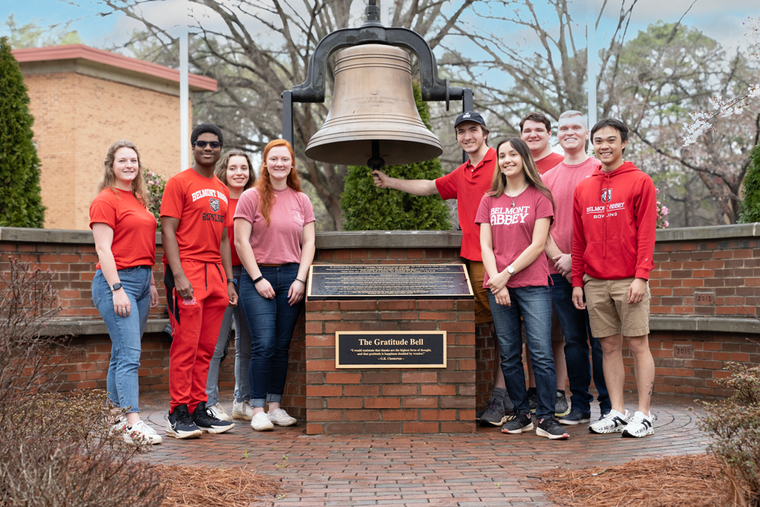Copyright ncregister

Traditions of campus life, some serious and some delightfully odd, serve to knit students into a spiritually robust community life. These quirky customs often do serious work in transmitting Catholic culture and fostering a sense of belonging for these young adults. What follows is a tour of distinctive traditions at five such institutions. The Gratitude Bell Dedicated in 2016, the Gratitude Bell at Belmont Abbey College in Belmont, North Carolina, sits near the campus cafeteria and invites students and visitors alike to ring it between noon and 3 p.m. in thanksgiving for their blessings. At noon, students gather to pray the Angelus and begin the three recognized hours of gratitude each day. Past president of the college, Bill Thierfelder, who announced his retirement earlier this summer, put it this way as he reflected on his tenure with the Register: “Gratitude is an important virtue to me,” Thierfelder explained. “I can actually hear the bell in my office. Every single time it rings, it brings a smile to my face because I know that somebody is thanking God. If I had one thing to share with everybody, I’d say, ‘Today, commit that in every circumstance, you’ll literally say it out loud, ‘Thank you, Jesus!’” Originally forged in 1915 by the McShane Foundry of Baltimore, Maryland, the bell was later purchased and donated to Belmont Abbey by several generous patrons. The Beanie Banquet Orientation at Benedictine College in Atchison, Kansas, culminates in the “Beanie Banquet,” at the end of ROC Week (Raven Orientation Camp), when freshmen receive the college’s symbolic cap, a beanie. As Jack Figge, who graduated last year and is working on his MBA at the college — and contributes to the Register — explained: These freshmen “must wear the beanie for the first week until the convocation Mass and ceremony. If an upperclassman catches you without a beanie, or if they manage to yank the beanie off, you have to stand on top of a table or the highest point around and caw like a raven at the top of your lungs while flapping your arms. People around you can either boo if they do not think you were loud enough or applaud if they are satisfied.” “A lot of students keep their beanies and then wear them during graduation under their cap and gown,” he added. Benedictine’s writer-in-residence, Tom Hoopes (and former executive editor of the Register), in a 2020 piece on Benedictine’s website, explained, “Your trajectory is going to be totally different if you launch from a beanie banquet into a culture of symbol and service than it would be without those aids.” “The rituals … are cultural. They are human,” Hoopes wrote. “These symbols are like a combination of the Boy Scouts and a fairy tale, a family and a public institution — an Abbey, a Mount, and a college.” Painting the Rock At Christendom College in Front Royal, Virginia, “The Rock” is a campus landmark that has been repainted by students for decades. After major sporting events, on feast days, and on other special occasions, groups gather “during the cover of darkness” as one student noted in The Chronicler, the college’s student paper, to repaint the big stone with class slogans, papal or national flags, or whatever art captures the moment. “Painting the rock has been a beloved Christendom tradition for nearly as long as the college has existed,” explained Zach Smith, the college’s director of communications. “Throughout the year, students decorate it to mark big moments — from the Irish flag on St. Patrick’s Day, to the Italian flag welcoming juniors home from Rome, to the papal flag celebrating the election of Pope Leo XIV this past April.” “Only at Christendom do you encounter students so excited about … a rock,” one alum remarked. Over the years, layer after layer of paint has turned it into a running chronicle of student life, marking victories, pranks, and moments of community spirit in vivid colors. Shakespeare as a Shared Tradition At Thomas Aquinas College, the feast of its patron is marked with pageantry and play. “Students on both coasts celebrate in grand style,” said Chris Weinkopf, the college’s executive director of college relations, including “Trivial and Quadrivial Pursuits.” Alongside this feast-day revelry, TAC also maintains one of its oldest traditions: the spring Shakespeare production. “TAC students perform one of Shakespeare’s plays every spring on both campuses,” Weinkopf noted. “The tradition goes back to the earliest days of the college. … Shakespeare’s plays feature heavily in the junior year curriculum, but they were meant to be performed — and seen!” Recent performances have included Love’s Labour’s Lost, Hamlet and A Midsummer Night’s Dream. The Wilderness Trek At Wyoming Catholic College (WCC) in Lander, Wyoming, orientation doesn’t take place in the classrooms or Student Union. Instead, every freshman embarks on a mandatory 21-day wilderness expedition that includes backpacking and mountaineering in the Rockies before the semester begins. This outdoor trek, unique among Catholic colleges, functions as both an initiation into your WCC identity and a bonding ritual in which friendships are forged before pen hits paper. Alongside this, at WCC, students learn “horsemanship in the Wyoming wilderness,” including learning to ride and care for these noble creatures as a core requirement for graduation. The college explains that the program “provides students with lessons in humility, leadership, and perseverance” while also connecting them to Wyoming’s western heritage. Why These Customs Matter These Catholic colleges show how these traditions — whether playful, prayerful, or something in between — serve the same deeper purpose. They bind students to one another, give shape to daily life, and anchor young Catholics in a faith that can too easily seem abstract or distant. Their collective message shows how Catholic life is meant to be lived: in gratitude, in joy and in communion.



